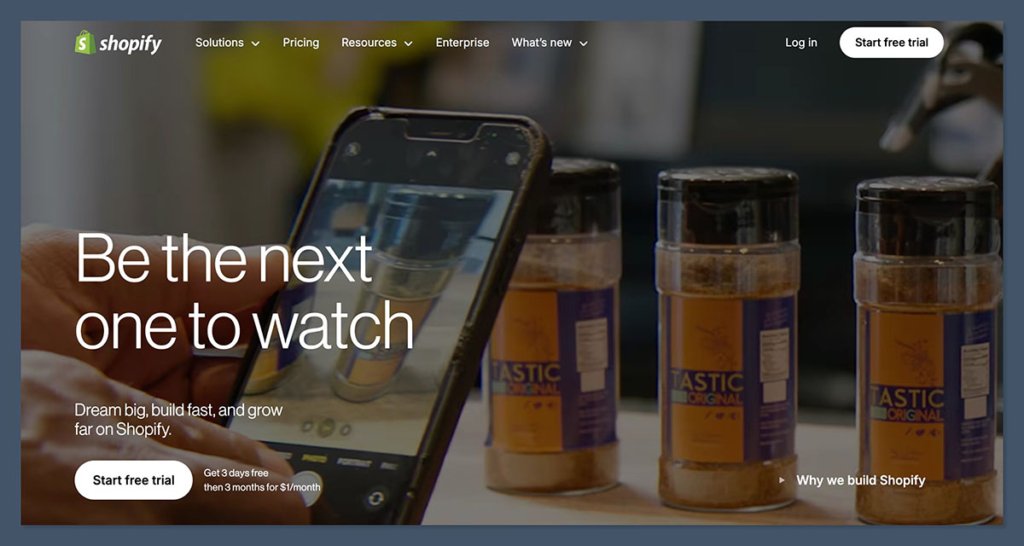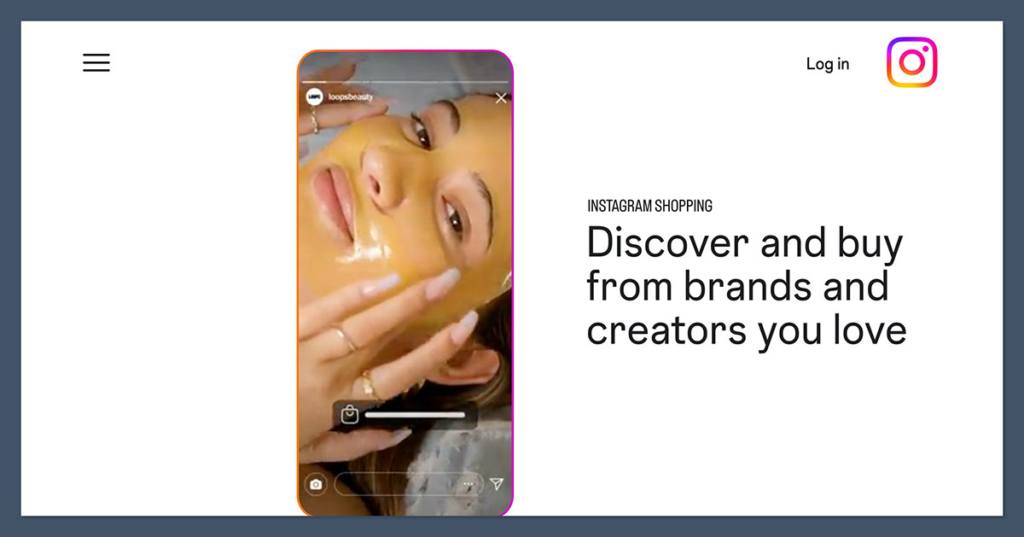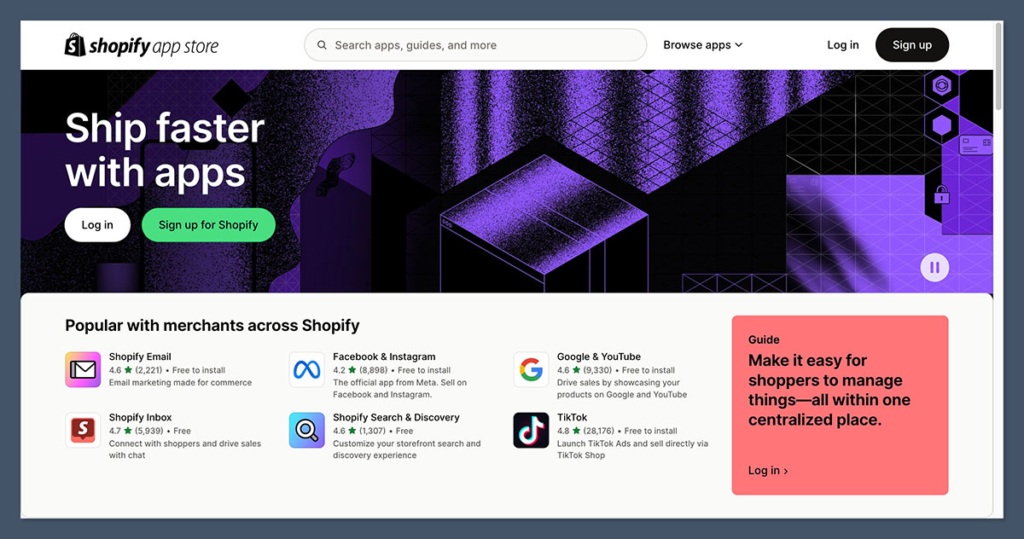
Shopify and Instagram Shop are two popular platforms for selling products online — but which one is right for your business?
We’ve tested both tools extensively and used them across multiple ecommerce projects to bring you a clear, no-nonsense verdict.
When it comes to building a real brand and owning your customer experience, Shopify comes out on top.
But if you’re looking for a fast, low-cost way to test products on social media, Instagram Shop still has a role to play.
Shopify vs Instagram Shop: Quick Verdict
Shopify – Best for full control, long-term growth, and brand-building
Instagram Shop – Best for testing products and social-first sales
In this comparison, I’ll take a closer look at how Shopify and Instagram Shop stack up — across pricing, product management, design, SEO, and more.
| Instagram Shop is best for: | Shopify is best for: |
|---|---|
| Creators, influencers, and small shops | Growing and large businesses with long-term goals |
| Testing new product ideas fast | Building a full-featured ecommerce brand |
| Driving quick sales through organic content | Managing complex inventory and advanced conversions |
Quick Comparison: Shopify vs Instagram Shop
Here’s a quick snapshot of how these two platforms compare:
| Feature | Shopify | Instagram Shop |
|---|---|---|
| Ownership | Full ownership | Owned by Meta |
| SEO Benefits | Yes | No |
| Design Flexibility | High | Very limited |
| Inventory Management | Advanced | Basic |
| Setup Speed | Slower | Very fast |
| Analytics | In-depth | Basic |
| Conversion Tools | Strong (checkout, upsells) | Limited |
| Retargeting | Full funnel | Top-of-funnel only |
| Payment Options | 100+ integrations | Meta checkout only (US focused) |
| Cost | $39/month+ | Free, but 5% fee per sale |
Best for Platform Ownership: Shopify

Shopify:
When I build a store on Shopify, I own everything — the customer journey, the branding, and most importantly, the data.
This means I can back up my store, switch themes, export my customer list, or even move to another platform entirely if I wanted.
There are no external dependencies outside of Shopify’s ecosystem.
Why platform ownership matters:
- You can build and maintain long-term SEO value
- You own your email list (which is gold)
- You control the checkout and upsell flows
- You’re protected from policy changes on social media platforms
- You can sell across multiple channels — your store stays central
Instagram Shop:
Instagram Shop is essentially a feature within the Meta universe. You’re operating on borrowed land.

If Meta changes the algorithm, restricts reach, or even bans your account — your entire store and audience disappear with it.
There’s no access to emails unless you direct users off-platform, and no way to build a CRM directly.
Risks with Instagram-only storefronts:
- Account bans can instantly remove your store
- Limited access to customer data (no ownership)
- Algorithm changes can destroy organic reach overnight
- You’re locked into Meta’s checkout rules (and fees)
| Ownership Comparison | Shopify | Instagram Shop |
|---|---|---|
| Own domain + website | ✅ Yes | ❌ No |
| Customer data access | ✅ Full | ❌ Limited |
| Export options | ✅ CSV, JSON, APIs | ❌ None |
| Risk of platform ban loss | ❌ Very low | ✅ Very high |
| Direct CRM integrations | ✅ Yes | ❌ No |
The Winner: 🏆 Shopify wins.
You own the brand, the audience, and the future.
Best for Pricing: Depends on Your Goals
Pricing plays a huge role in which platform makes sense — especially when you’re just starting out or trying to scale profitably.
Let’s break down the cost comparison between Shopify and Instagram Shop, not just by subscription pricing, but also by transaction fees, hidden costs, and long-term scalability.
| Pricing Tier | Shopify | Instagram Shop |
|---|---|---|
| Base Plan | $39/month (Basic Plan) | Free to use (if approved by Meta) |
| Special Offer | First 3 months at $1/month (limited time) | N/A |
| Transaction Fees | 2.9% + 30¢ per transaction (Shopify Payments) | 5% per sale (US only) |
| Additional App Costs | Can range from $5 to $50+ monthly | None — but no app ecosystem either |
| Custom Domain | Included with most Shopify plans | Not supported |
| Hosting + SSL | Included | Handled by Meta |
| Free Trial | 3-day free trial | No trial — just apply for approval |
Shopify Pricing: More Upfront, More ROI Long-Term
Shopify starts at $39/month for the Basic plan, which gives you everything you need to run a store: a branded domain, mobile-responsive theme, secure checkout, marketing tools, and advanced analytics.
But here’s where it gets better:
✅ Shopify is currently offering 3 months at just $1/month — which means you can get a fully functional online store for only $3 total while you build traction.
Other plan options include:
- Shopify Plan – $105/month (better for scaling and teams)
- Advanced Plan – $399/month (built for high-volume stores with detailed reports and lower fees)
Transaction fees are 2.9% + 30¢ unless you use Shopify Payments — which lowers the rate and eliminates third-party fees.
Over time, the extra features and control you get make the cost worth it. Especially if you’re generating hundreds or thousands of orders per month.
Instagram Shop Pricing: Free to Start, But You’ll Pay With Control
Instagram Shop is technically free — there’s no subscription. You can start selling directly from your Instagram business profile without paying a monthly fee.
But there are strings attached:
- Meta takes a 5% cut per sale (or a flat fee of $0.40 on orders under $8) — only if you’re in a supported country (mainly the US)
- You’ll need to spend on ads to drive traffic. Organic reach is not reliable
- You can’t customise the checkout, upsell, or collect emails
- No ownership of your customer list = harder to re-engage buyers
Also, the 5% transaction fee adds up. Let’s say you make $10,000 in monthly sales — you’re paying $500/month in fees on Instagram vs $290/month + fees on Shopify (with more control and data).
Which One Is Cheaper?
Short-term?
Instagram Shop wins — it’s free, simple, and great for testing product ideas.
Long-term?
Shopify wins — you’ll save money on paid ads, own your customer data, and get better conversion tools to improve profit margins.
Hidden Costs Breakdown
| Cost Type | Shopify | Instagram Shop |
|---|---|---|
| App costs (average) | $20–$60/month depending on needs | N/A |
| Transaction fees (monthly) | $100–$300 (varies by volume) | $0–$500+ depending on volume |
| Ad budget needed | Optional — SEO and email possible | Often required to generate sales |
| Ownership value | High (brand, traffic, email list) | None (platform owns everything) |
The Winner:
Instagram Shop wins for beginners and low-risk testing.
If you’re launching a product and want a simple, low-commitment way to validate demand, Instagram Shop works.
Shopify wins if you want to grow a real business.
The cost gives you total control, SEO traffic, customer ownership, and better profit margins at scale.
Best for Getting Started Quickly: Instagram Shop
Shopify:
Starting from scratch on Shopify takes some upfront effort — especially if you want your site to look sharp and be conversion-optimised.
You’ll go through:
- Picking a theme
- Customising your layout
- Adding collections and categories
- Setting up taxes, shipping, and payment gateways
- Installing third-party apps (if needed)
It’s a commitment — but the end result is a fully owned business that can scale infinitely.
Instagram Shop:
Setup is super fast — especially if you already have an Instagram business page. You just:
- Connect your catalog through Meta Commerce Manager
- Get approved
- Tag products in posts and Stories
- Start selling inside the app
No coding. No design. No hosting. Just product tagging and posting.
| Setup Comparison | Shopify | Instagram Shop |
|---|---|---|
| Time to launch | 2–10 hours | <1 hour |
| Design flexibility | ✅ Full | ❌ None |
| Hosting required | ✅ Yes | ❌ No |
| Ideal for testing fast | ❌ Not ideal | ✅ Perfect |
| Long-term growth ready? | ✅ Absolutely | ❌ Not scalable alone |
The Winner: 🏆 Instagram Shop wins for speed and ease of use. If you need to test demand today, it’s unbeatable. Just don’t stop there.
Best for Design and Branding: Shopify
Shopify:
Shopify’s design system is one of the most flexible in ecommerce. You can:
- Choose from 200+ templates (13 free, rest paid)
- Customise colours, fonts, section blocks, navigation, and layout
- Add custom code (HTML, CSS, Liquid) if needed
- Use Shopify’s drag-and-drop editor or advanced theme builders
- Create high-converting landing pages for ads or product launches
You can build a store that looks like Nike or a boutique vintage brand — whatever fits your audience.
Instagram Shop:
Branding is almost non-existent. Everything sits inside Instagram’s layout. That includes:
- Product tags
- A product feed under your profile
- No custom landing pages
- No colour or font control
- No long-form product storytelling
Your only brand assets are your visuals and bio.
The Winner: 🏆 Shopify wins.
If your brand experience matters, Instagram Shop isn’t even in the same league.
Best for Inventory and Product Management: Shopify
Shopify:
You can run anything from a 1-product store to a 10,000+ SKU operation. Shopify makes it easy to:
- Add unlimited variants (size, colour, etc.)
- Create product bundles and subscriptions
- Tag and sort products into collections
- Sync with fulfilment providers and POS
- Use barcodes, SKU systems, and real-time tracking
- Add back-in-stock alerts, preorders, and low-stock warnings
Whether you’re running a clothing brand, supplement store, or digital course business — Shopify handles it all.
Instagram Shop:
You’re restricted to physical products and must sync through Commerce Manager. There’s no native support for:
- Digital downloads
- Subscriptions
- Product bundles or upsells
- Multi-variant control beyond basics
Also, managing inventory inside Meta’s dashboard is less intuitive than Shopify.
| Inventory Feature | Shopify | Instagram Shop |
|---|---|---|
| Digital products | ✅ Yes | ❌ No |
| Subscription support | ✅ Native & apps | ❌ No |
| Complex variants | ✅ Full support | ⚠️ Limited |
| Real-time inventory sync | ✅ Yes | ⚠️ Via catalog only |
The Winner: 🏆 Shopify wins.
Built to grow with you — even if you scale from 5 to 5,000 products.
Best for SEO and Long-Term Traffic: Shopify
Shopify:
SEO is Shopify’s superpower. You can optimise every product page, blog, and collection to rank in Google. Here’s what you can control:
- Meta titles & descriptions
- Header tags (H1, H2, etc.)
- Clean URLs
- Image alt text
- Schema markup via apps
- Internal linking
- Page speed (using fast themes or Shopify hosting)
You can even install blog apps, structured product review plugins, and index sitemap.xml with Google Search Console.
Instagram Shop:
No SEO benefits at all. Product pages don’t rank. There’s no search engine traffic. You rely entirely on social media engagement or ads.
| SEO Feature | Shopify | Instagram Shop |
|---|---|---|
| Indexed on Google | ✅ Yes | ❌ No |
| Customisable URLs | ✅ Yes | ❌ No |
| Blog support | ✅ Built-in | ❌ None |
| SEO plugins/apps | ✅ Thousands | ❌ Not supported |
The Winner: 🏆 Shopify wins.
If you want free traffic over time — this is how you build it.
Best for Conversions and Checkout: Shopify
Shopify:
The checkout experience is everything — and Shopify lets you optimise it like a pro:
- Add upsells, BOGO offers, bundles
- Use urgency timers or exit-intent popups
- A/B test pricing and copy
- Offer multiple payment methods (Stripe, PayPal, Klarna, etc.)
- Abandoned cart recovery built-in
- Track the entire funnel in detail
It’s smooth, fast, and high-converting — especially with apps like ReConvert or Zipify.
Instagram Shop:
Checkout works inside the app (only in supported regions), or redirects users off-site. The user leaves Instagram, which increases drop-off. You also can’t edit the checkout flow, show trust badges, or capture emails unless users buy.
The Winner: 🏆 Shopify wins. Higher conversion rates, more control, more money left in your pocket.
Best for Data and Analytics: Shopify
Shopify:
Analytics are deep and actionable. You get:
- Conversion rate by product, source, and device
- Customer lifetime value (LTV)
- Channel attribution
- Funnel drop-off reports
- Retention reports
- Integrations with GA4, Hotjar, Triple Whale, etc.
You can even create custom dashboards to track things like:
- Email performance
- Facebook ad ROAS
- Best-selling products by day/hour
Instagram Shop:
Basic analytics only. You’ll see:
- Product impressions
- Post engagement
- Click-throughs
- Reach
- Top-performing content
But that’s it. No deep funnel tracking or LTV reporting.
| Analytics Feature | Shopify | Instagram Shop |
|---|---|---|
| Real-time revenue data | ✅ Yes | ❌ No |
| Funnel tracking | ✅ Full | ❌ None |
| Custom reports | ✅ Yes | ❌ No |
| Ad performance integrations | ✅ All platforms | ⚠️ Meta-only |
The Winner: 🏆 Shopify wins.
You need data to grow — and Instagram doesn’t give you nearly enough.
Best for Advertising and Retargeting: Tie
Shopify:
Integrates seamlessly with Meta Ads, Google Ads, TikTok, and Pinterest. With apps like Klaviyo, Postscript, or Omnisend, you can build full-funnel email and SMS retargeting campaigns.
Some examples:
- Cart abandoners see a Facebook ad
- Viewed product = email with dynamic product recommendation
- Purchase = triggered upsell via SMS
- Repeat buyer = loyalty campaign
- A/B test ads by channel and ROAS
Instagram Shop:
One of the most powerful top-of-funnel platforms for ecommerce.
You can tag products in posts and stories, run shoppable ads, and reach millions of users with highly visual content. But… you don’t control the funnel.
Limitations:
- Can’t retarget based on detailed customer behaviour
- Can’t segment by cart size, LTV, or purchase history
- No backend email capture or list segmentation
| Funnel Stage | Shopify | Instagram Shop |
|---|---|---|
| Awareness | ✅ via ads and content | ✅ via posts + reels |
| Retargeting | ✅ full control | ❌ limited to ad retargeting |
| Conversion optimisation | ✅ upsells + flows | ❌ Instagram checkout only |
| CRM integration | ✅ Klaviyo, ActiveCampaign | ❌ Not native |
The Winner:
It’s a tie. Use Instagram for visibility and Shopify to close and retain. Best results come from using both together.
Best for Integrations and Customisation: Shopify
Shopify:
With over 8,000+ apps in its app store, Shopify’s ecosystem is unmatched.

Whether you need loyalty programs, live chat, subscriptions, analytics, influencer marketing, or upsell tools — there’s an app for it.
Top integration types:
- CRM tools like HubSpot, Klaviyo, Mailchimp
- Subscription tools like Recharge or Skio
- Review apps like Judge.me, Yotpo
- Custom checkout logic (gift with purchase, free shipping tiers)
- Print-on-demand platforms like Printful, Gelato
You can also build custom apps or headless storefronts using the Shopify API if you’re scaling fast.
Instagram Shop:
Integrations are limited to Meta-approved platforms. You can connect Instagram to Shopify, BigCommerce, and Commerce Manager — but beyond that, you’re stuck.
Limitations:
- No custom app store
- Can’t run unique campaigns without external tools
- Very few native analytics or loyalty systems
| Integration Type | Shopify | Instagram Shop |
|---|---|---|
| Email/SMS marketing | ✅ Klaviyo, Omnisend | ❌ Not supported |
| Subscription products | ✅ Recharge, Bold | ❌ |
| Custom checkout integrations | ✅ via apps | ❌ |
| Influencer tracking | ✅ via Gatsby, Upfluence | ❌ |
The Winner: Shopify wins. You can stack your tech, automate your workflows, and scale faster.
Final Verdict: Shopify Is the Better Long-Term Ecommerce Platform
If you want to build a long-term business, own your traffic, and grow a brand — Shopify is the better platform.
Instagram Shop is great for exposure — it helps people discover your products and can drive traffic to your site. But it’s not enough on its own to scale or build customer relationships.
Who should use both?
Honestly? I recommend using both together.
Sync your Shopify catalog with Instagram Shop to get the reach and social validation, while using Shopify as your main store, funnel, and checkout system.
That combo gives you reach + control — and that’s how you win in ecommerce.






